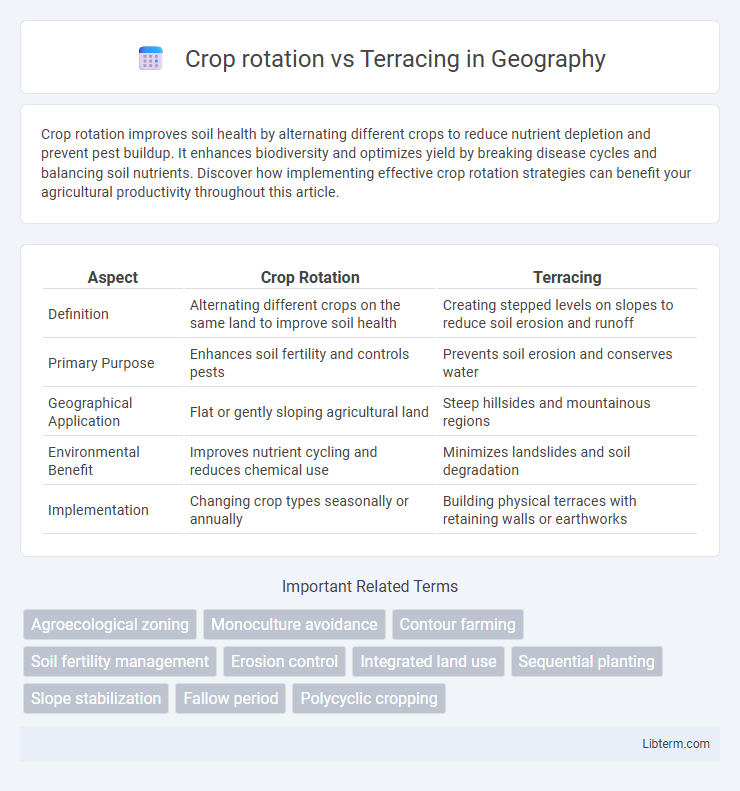Crop rotation improves soil health by alternating different crops to reduce nutrient depletion and prevent pest buildup. It enhances biodiversity and optimizes yield by breaking disease cycles and balancing soil nutrients. Discover how implementing effective crop rotation strategies can benefit your agricultural productivity throughout this article.
Table of Comparison
| Aspect | Crop Rotation | Terracing |
|---|---|---|
| Definition | Alternating different crops on the same land to improve soil health | Creating stepped levels on slopes to reduce soil erosion and runoff |
| Primary Purpose | Enhances soil fertility and controls pests | Prevents soil erosion and conserves water |
| Geographical Application | Flat or gently sloping agricultural land | Steep hillsides and mountainous regions |
| Environmental Benefit | Improves nutrient cycling and reduces chemical use | Minimizes landslides and soil degradation |
| Implementation | Changing crop types seasonally or annually | Building physical terraces with retaining walls or earthworks |
Introduction to Crop Rotation and Terracing
Crop rotation involves systematically alternating different crops in the same field across seasons to improve soil fertility, reduce pest cycles, and enhance crop yields. Terracing transforms sloped land into a series of flat, stepped platforms to prevent soil erosion and manage water runoff effectively. Both techniques are vital in sustainable agriculture, combining soil conservation with productivity enhancement.
Historical Background of Crop Rotation
Crop rotation traces its origins to ancient civilizations such as Mesopotamia and Egypt, where early farmers practiced the systematic alternation of crops to maintain soil fertility and reduce pests. This sustainable agricultural technique evolved through the Middle Ages and was scientifically refined during the 18th-century agricultural revolution in Europe, significantly improving crop yields. Unlike terracing, which is primarily a land management method aimed at preventing soil erosion on slopes, crop rotation directly enhances soil health by replenishing nutrients and breaking pest cycles.
Origins and Development of Terracing
Terracing originated over 4,000 years ago in ancient civilizations such as the Inca and Ifugao, designed to maximize arable land on steep slopes by creating flat platforms that reduce soil erosion and water runoff. This agricultural innovation developed through trial and adaptation in mountainous regions, enabling sustainable crop production in challenging terrains. Crop rotation, by contrast, evolved as a soil fertility management practice rather than a landscape modification.
Core Principles of Crop Rotation
Crop rotation involves systematically alternating different crops on the same land to enhance soil fertility, reduce pest and disease cycles, and improve crop yield. This practice optimizes nutrient use by growing legumes that fix nitrogen, followed by nutrient-demanding crops, maintaining soil health and structure. Terracing, on the other hand, primarily focuses on reducing soil erosion and water runoff on sloped lands but does not inherently address nutrient management or pest control like crop rotation.
Essential Techniques in Terracing
Terracing involves creating stepped levels on slopes to reduce soil erosion and manage water runoff, essential for sustainable agriculture in hilly terrains. Key techniques include constructing retaining walls, shaping contour-based terraces, and improving drainage systems to prevent soil degradation. Unlike crop rotation, which focuses on alternating crops to enhance soil fertility, terracing physically alters the landscape to preserve topsoil and increase arable land.
Environmental Benefits: Crop Rotation vs Terracing
Crop rotation enhances soil fertility and reduces pest and disease buildup by alternating crops, leading to improved biodiversity and decreased reliance on chemical fertilizers. Terracing controls soil erosion on steep slopes by creating flat surfaces, which conserves water and reduces runoff, thereby preventing land degradation. Both practices contribute to sustainable agriculture by promoting soil health and water conservation, but crop rotation primarily benefits soil nutrient cycles while terracing addresses soil stability and erosion control.
Soil Health and Erosion Control Comparison
Crop rotation enhances soil health by alternating nutrient-demanding plants with nitrogen-fixing legumes, reducing pest buildup and improving soil structure. Terracing primarily prevents soil erosion on slopes by creating level steps that slow water runoff and retain topsoil, directly minimizing erosion risks. While crop rotation promotes nutrient cycling and biological activity in soil, terracing provides physical erosion control, making them complementary techniques for sustainable land management.
Economic Impacts on Farmers
Crop rotation enhances soil fertility and reduces the need for chemical fertilizers, leading to lower input costs and increased yields, which boosts farmers' profitability. Terracing involves significant initial investment and labor for construction and maintenance but helps prevent soil erosion and improves water retention, ultimately protecting crop productivity and securing long-term income. Farmers benefit economically from crop rotation's immediate cost savings and from terracing's erosion control, which sustains land value and crop output over time.
Challenges and Limitations of Each Method
Crop rotation faces challenges such as the need for accurate knowledge of crop compatibility and soil nutrient requirements, with limitations including the time needed to see soil fertility benefits and the risk of pest cycles if not managed properly. Terracing presents limitations due to high labor and maintenance costs, susceptibility to erosion if poorly constructed, and constraints in steep or unstable terrains that may reduce its long-term effectiveness. Both methods require careful planning and management to overcome these challenges and maximize sustainable agricultural productivity.
Choosing the Right Practice: Factors to Consider
Selecting between crop rotation and terracing depends on soil type, slope gradient, and erosion risk. Crop rotation enhances soil fertility and pest control on flat or gently sloping farmland, while terracing is ideal for steep terrains to prevent soil erosion and water runoff. Farmers must assess land topography, climate conditions, and long-term sustainability goals to determine the optimal soil conservation strategy.
Crop rotation Infographic

 libterm.com
libterm.com